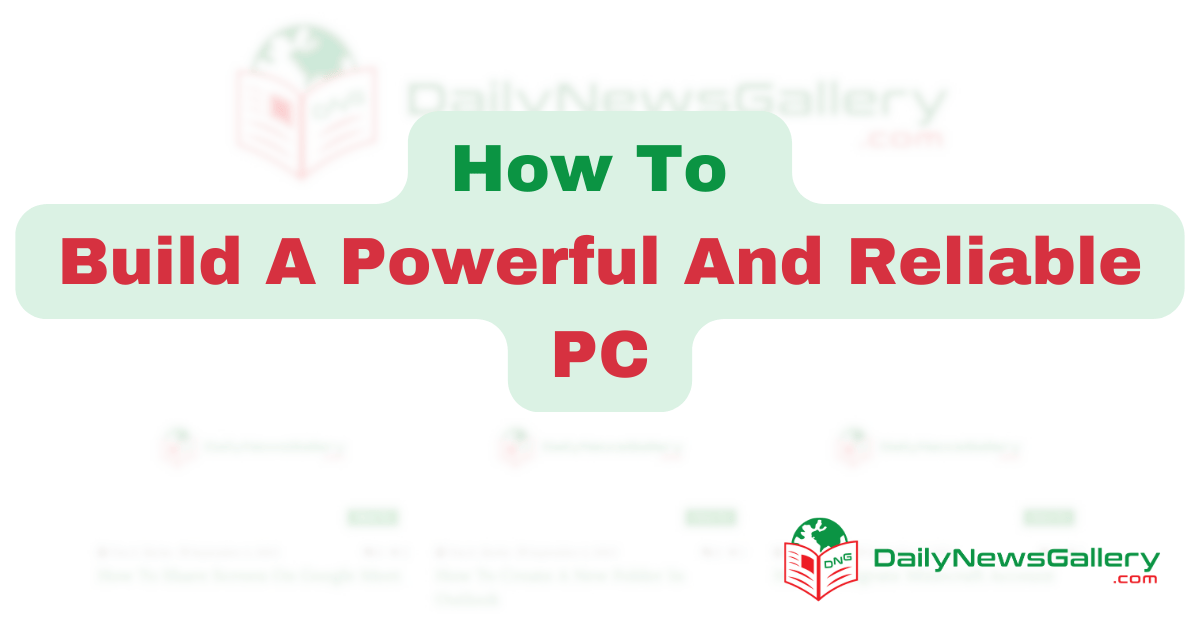
Are you done with having to deal with slow computers that can’t keep up with your needs? Are you longing for a powerful and dependable PC that can handle anything from video gaming to graphic design with ease? Don’t worry. We are here to guide you in constructing your very own high-performance machine that will transform your computing experience. Whether you are a tech-savvy individual or a novice, we are here to support you with step-by-step instructions, expert advice, and a complete list of components that will guarantee your PC is the best of the best.
Constructing your own PC is not just a gratifying experience, but it also gives you full control over the specs and power of your machine. From selecting the right processor and graphics card to maximizing cooling and storage alternatives, every decision you make will have an effect on the overall power and dependability of your PC. So, if you’re ready to embark on an exhilarating journey of assembling advanced technology and unlocking its true potential, join us as we explore the world of PC building and uncover the secrets to constructing a powerful machine.

How to Build a Powerful and Reliable PC:
- Step 1: Research and choose compatible components, such as a powerful processor, ample RAM, and a reliable motherboard.
- Step 2: Assemble the components carefully, following the manufacturer’s instructions.
- Step 3: Install the operating system and necessary drivers.
- Step 4: Perform thorough system testing to ensure stability and reliability.
- Step 5: Optimize the PC’s performance by adjusting settings and installing useful software.
Building a Powerful and Reliable PC
In today’s fast-paced world, having a powerful and reliable PC is essential. Whether you’re a gamer, a graphic designer, or simply someone who needs a reliable machine for everyday tasks, building your own PC can provide you with the performance and customization options you desire. This guide will walk you through the step-by-step process of building a powerful and reliable PC that meets your specific needs.
Step 1: Determine Your Needs and Budget
Before embarking on the journey of building your own PC, it’s important to determine your specific needs and budget. Consider the tasks you’ll be performing on your PC, such as gaming, video editing, or office work, and assess the level of performance required. Additionally, set a realistic budget that allows you to obtain the components necessary for your desired level of performance.
Once you have a clear understanding of your needs and budget, you can proceed to the next step of selecting the components for your PC.
Step 2: Selecting the Components
When it comes to building a powerful and reliable PC, choosing the right components is crucial. Here are the key components you’ll need:
- Processor (CPU): The brain of your computer, responsible for executing instructions and performing calculations.
- Graphics Card (GPU): Essential for gaming and graphic-intensive tasks, responsible for rendering images and videos.
- Memory (RAM): Determines how many tasks your PC can handle simultaneously; the higher the RAM, the better the multitasking capabilities.
- Storage: Choose between a Solid State Drive (SSD) for faster performance or a Hard Disk Drive (HDD) for higher storage capacity.
- Motherboard: The main circuit board that connects all the components together.
- Power Supply Unit (PSU): Supplies power to all the components in your PC.
- Casing: Provides protection and houses all the components.
- Cooling System: Ensures that your PC doesn’t overheat during intensive tasks.
Research each component carefully, considering factors such as compatibility, performance, and brand reputation. Once you’ve made your choices, you can move on to the next step of assembling your PC.
Step 3: Assembling Your PC
Now that you have all the necessary components, it’s time to put them together. Follow these steps:
- Prepare your workspace by ensuring it’s clean, well-lit, and static-free.
- Start by installing the CPU onto the motherboard, following the manufacturer’s instructions.
- Insert the RAM into the appropriate slots on the motherboard.
- Mount the motherboard into the casing, securing it with screws.
- Connect the power supply to the motherboard and other components, ensuring all connections are secure.
- Install the graphics card into the appropriate slot on the motherboard.
- Connect the storage devices, such as SSD or HDD, to the motherboard.
- Attach the cooling system to the CPU to prevent overheating.
- Double-check all connections and ensure everything is properly secured.
- Close the casing, and your PC is now ready for use.
It’s important to note that these steps provide a general overview, and the specific instructions may vary depending on the components you’ve chosen. Always refer to the manufacturer’s instructions for detailed guidance.
Frequently Asked Questions
Here are some commonly asked questions about building a powerful and reliable PC.
Question 1: What are the essential components needed to build a powerful PC?
Building a powerful PC requires several essential components. These include a high-performance processor, a reliable motherboard, ample RAM, a powerful graphics card, a fast storage solution such as an SSD, a reliable power supply unit, and a well-ventilated case for cooling. Each component plays a crucial role in determining the overall performance and reliability of the PC.
The processor is the brain of the computer, and a high-performance one is essential for tasks such as gaming or video editing. The motherboard serves as the foundation for all other components and must be compatible with the chosen processor and RAM. Sufficient RAM is crucial for multitasking and running resource-intensive applications smoothly. A powerful graphics card is necessary for gaming or graphic-intensive tasks. A fast storage solution, such as an SSD, ensures quick boot times and fast data access. A reliable power supply unit is necessary to provide stable and sufficient power to all components. Finally, a well-ventilated case helps in maintaining proper temperature levels and prevents overheating.
Question 2: How do I choose the right processor for my PC?
Choosing the right processor for your PC depends on your specific requirements and budget. Consider factors such as the intended use of the PC, the level of performance you desire, and the compatibility with other components. Processors come in different models and generations, each offering varying levels of performance.
If you are primarily using your PC for everyday tasks and light usage, a mid-range processor would suffice. However, if you are into gaming, video editing, or other resource-intensive tasks, you should opt for a high-performance processor. Consider the number of cores and clock speed of the processor, as these factors greatly impact its performance. Additionally, ensure that the processor is compatible with the chosen motherboard and supports the required socket type.
Question 3: How much RAM do I need for a powerful PC?
The amount of RAM you need for a powerful PC depends on the type of tasks you will be performing. For general multitasking, web browsing, and light usage, 8GB of RAM is usually sufficient. However, if you are into gaming, video editing, or running multiple resource-intensive applications simultaneously, it is recommended to have at least 16GB or even 32GB of RAM.
Having more RAM allows for smoother multitasking and better performance when dealing with large files or memory-intensive applications. It also helps in future-proofing your PC, as software requirements tend to increase over time. However, it’s important to note that having excess RAM beyond your usage requirements will not provide any additional performance benefits.
Question 4: What factors should I consider when selecting a graphics card?
When selecting a graphics card for your PC, there are several factors to consider. The first is the intended use of your PC. If you are a casual user or primarily use your PC for office work, a basic graphics card will suffice. However, if you are a gamer or working with graphic-intensive applications, you will need a more powerful graphics card.
Consider the graphics card’s VRAM (Video RAM) capacity, clock speed, and the number of CUDA cores (for NVIDIA cards) or Stream Processors (for AMD cards). These factors determine the graphics card’s performance capabilities. Additionally, make sure the graphics card is compatible with your motherboard and power supply. Some high-end graphics cards may require additional power connectors or occupy multiple slots, so ensure your system can accommodate them.
Question 5: How important is a good cooling system for a powerful PC?
A good cooling system is crucial for a powerful PC to ensure optimal performance and longevity. When your PC components generate heat, they need to be cooled down to prevent thermal throttling and potential damage. There are two main types of cooling systems: air cooling and liquid cooling.
An air cooling system consists of fans that help dissipate heat by blowing cool air over the components. It is a cost-effective and reliable solution for most PCs. On the other hand, liquid cooling involves circulating liquid coolant through tubes and a radiator to dissipate heat more efficiently. Liquid cooling is more effective for overclocked systems or high-performance PCs, but it can be more expensive and require additional maintenance.
Regardless of the cooling system you choose, it is essential to have proper airflow within the case, ensuring that hot air is expelled efficiently. Additionally, regular cleaning and maintenance of the cooling system will help in maintaining optimal performance and reliability.
To sum it up, constructing a strong and dependable PC may feel like a challenging undertaking, however, with the proper information and advice, it can be a very fulfilling experience. By carefully choosing top-notch components, guaranteeing proper setup and cooling, and performing exhaustive testing, you can create a PC that not only meets your present needs but also has the capacity for future enhancements.
Keep in mind, that building a PC isn’t only about the technical aspects; it’s also a chance to express your individuality and creativity. Whether you’re an avid gamer, a graphic designer, or a professional content creator, customizing your PC enables you to tailor it to your distinct requirements and preferences. So, take the time to research, plan, and assemble your PC with care. The result will be a reliable and powerful machine that brings joy and fulfillment each time you use it. Begin your journey into the world of PC building today and open the boundless chances that await you.






